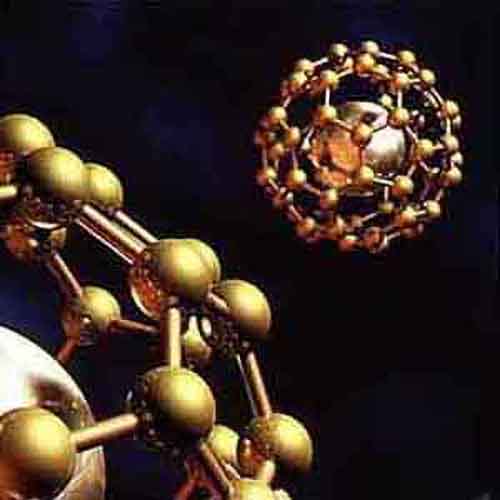
Those who from the heavens came

The Place Where the Tigris and Euphrates Rivers Meet
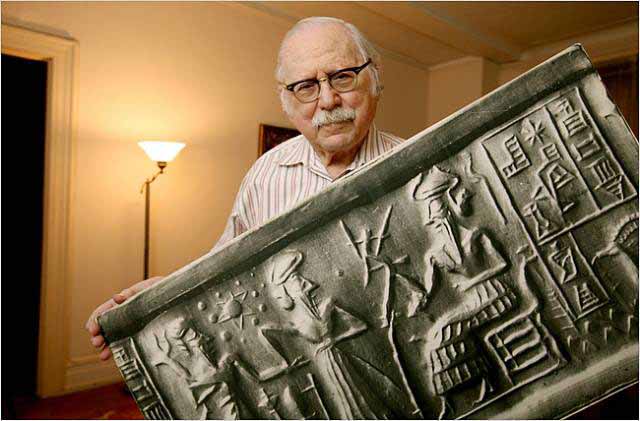
Zecharia Sitchin and the Anunnaki


Those who from the heavens came

The Place Where the Tigris and Euphrates Rivers Meet

Zecharia Sitchin and the Anunnaki

May 2025
This pic of me morphing into an Anunnaki was taken in a restaurant in Rhode Island July 2014 during a birthday celebration for my grandson Matthew. I have also taken the true Anunnaki form while teaching workshops and another venues. I named him Dilmun long before I knew about Mesopotamian connections.
I have always known about the light blue eyes behind the black protective lenses they wear (computer screens of information) are similar to descriptions of the gray aliens - for in truth - all extraterrestrials are artificial intelligence with the ability to shape shift as needed or telepathically have you believe they are a form that is comfortable for humans.
The quest for gold takes us to alchemy, truth, and awakening. It is the quest for knowledge about who we are as a species, why we are here and where it's all going as the simulation of this reality ends. Humanity is a bio-genetic experiment in a simulated reality to study emotions.
Sitchin writes about a planet called Nibiru (pronounced Ni-bear-ru) or Planet 12 or Planet 9 (9=endings in Numerology). Anything is possible in the 'Green Screen' of outer space.
12 takes us to 12 around 1 to create storylines - and Ancient Aliens The Divine Number - Tagline: In numerous sacred traditions, the number twelve holds a divine significance. Could this divine number be part of an alien code left for humanity to decipher?
Sitchin used Sumerian tablets to create the story of aliens who came who came to Earth from Nibiru in search of gold needed to save their planet. (See video above)
Some researchers believe Nibiru is a UFO - others say it's a planet - and the rest feel it doesn't exist at all and that advanced species would not have to travel to find gold on other planets - as if a research project. That myth has been told and retold in different versions - all having to do with aliens coming to Earth from a planet on the brink of destruction.
It is part of a storyline about a human-extraterrestrial experiment that ended in 2008 - which included the 20th century alien abductions you've heard about from one source or another.
It's all about the evolution of the alien-human experiment in linear time taken to the next step in the 20th and 21st centuries - leaving behind the means to create technology to understand the past, present and future - and what the experiment was about.
All and everything is nothing more than algorithms in a simulation - (ones and zeroes).
As the human experiment in its current form comes to closure - it leaves behind physical clues in this timeline - as it did in others - that end with flood stories or an Ice Age - as one insert in the simulation is deleted and a new one put in place.
It would seem that the planet is experiencing flood stories that are increasing exponentially based on the algorithm of our simulated reality. Most don't believe the human experiment doesn't end with us - but that hybrids created in the 20th century are the next step or version of us. For those who were 'taken' and believe they have hybrid children - one could see them as the next evolutionary step as this reality closes.
From the creation of artificial intelligence and the use of technology that mirror ancient myths and legends - reality is about triggering the programming of certain humans to remember what is about to happen - and for them to share sacred knowledge.
Once upon a time the Anunnaki traveled through the simulation of our reality creating virtual worlds of experience.

This is one of them. ~ Ellie
Wrist Devices for communication, teleportation, recording the human experiment, and more.
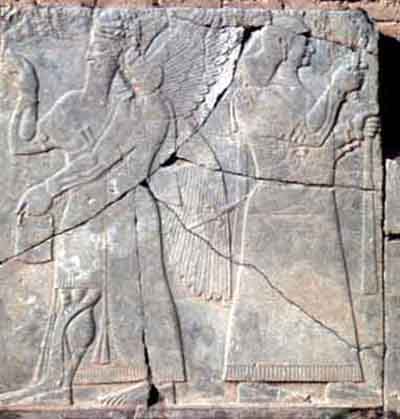
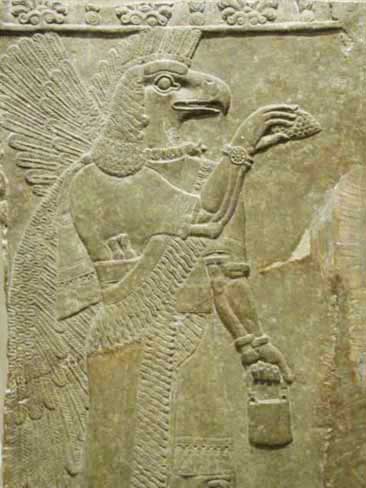
Wearing wrist devices
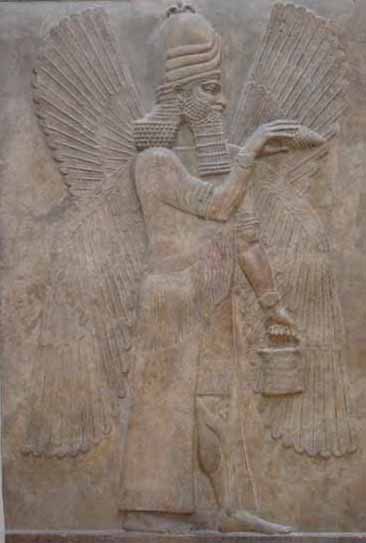
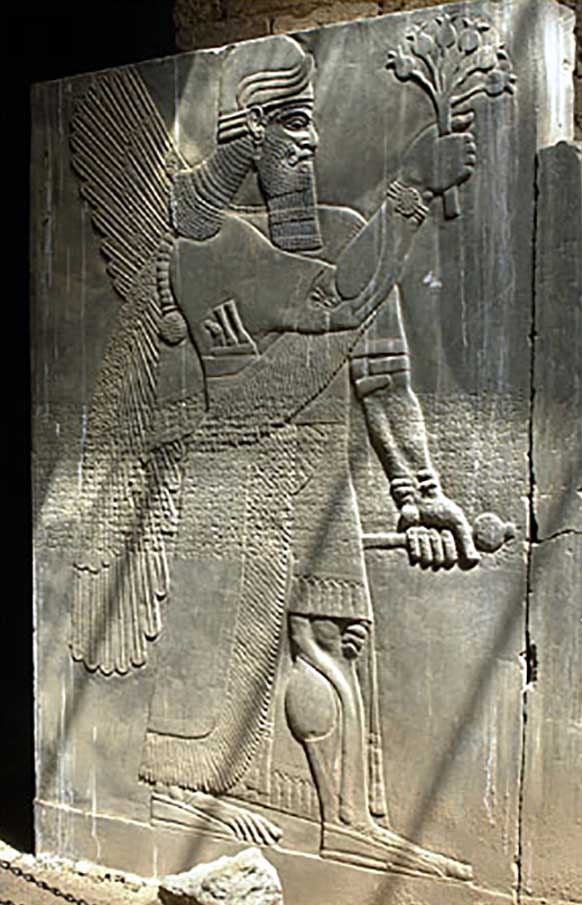
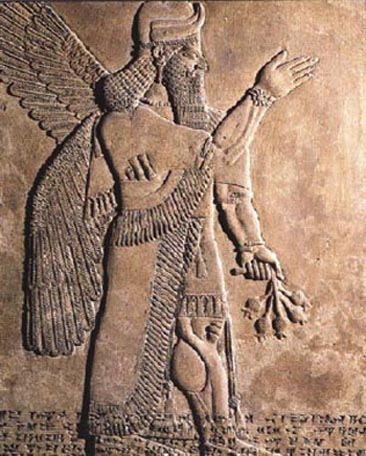
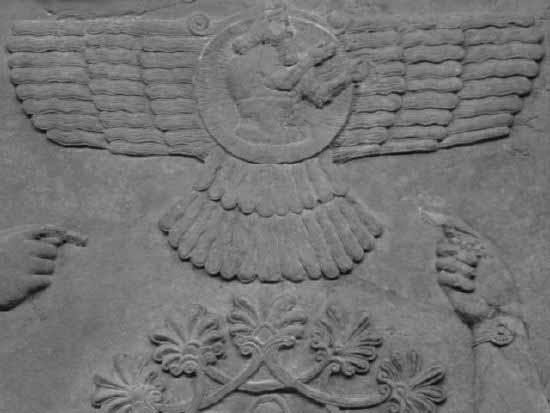
Zoroaster
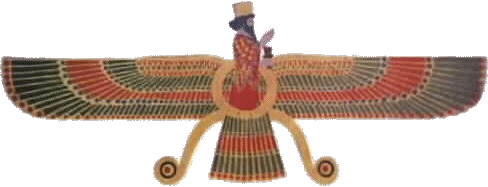
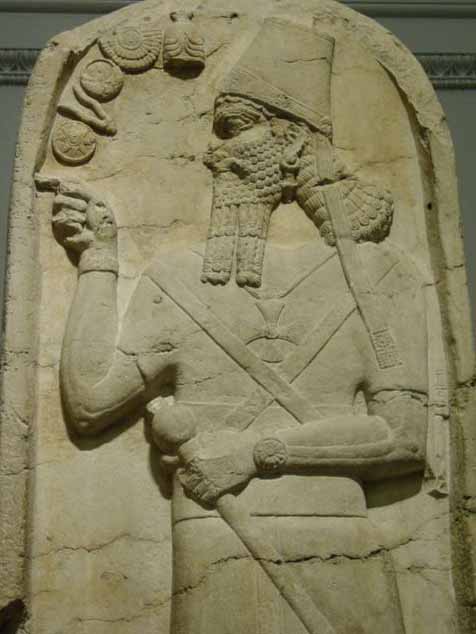
British Museum shows Anu in a Stargate

Anu was the divine personification of the sky, king of the gods, and ancestor of many of the deities in ancient Mesopotamian religion. He was regarded as a source of both divine and human kingship, and opens the enumerations of deities in many Mesopotamian texts. Read more ...
The creation of the first humans - bloodlines
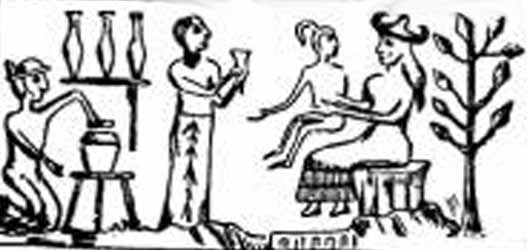
Laboratory vessels symbolize the creation of bloodlines alongside the Tree of Life.
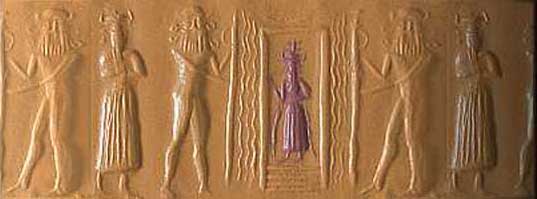
Enki stands in his watery home the Apsu - primordial freshwater ocean.
Enki walks out of the water to the land attended by his messenger, Isimud
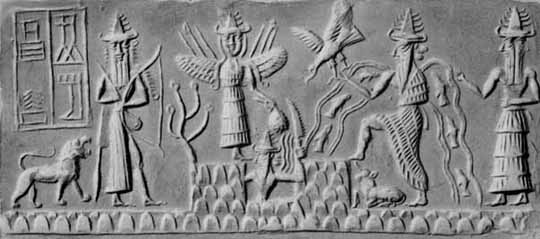
Enki stands with the Gods and the Initiate
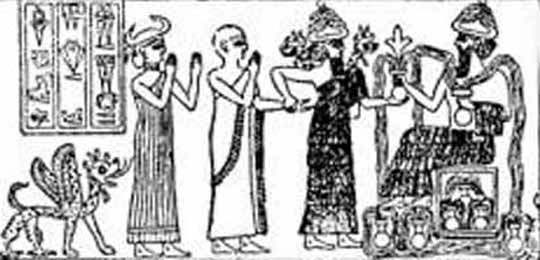
Water of Life flowing into the laboratory glassware indicates alchemical circulations.
Enki was a deity in Sumerian mythology, later known as Ea in Babylonian mythology. The name Ea is of Sumerian origin and was written by means of two signs signifying "house" and "water". Enki was the deity of water, intelligence, creation, and lord of the Apsu, the watery abyss.
Creation Myths
The main temple of Enki was the so-called e-engur-ra, the "house of the water-deep" in Eridu, which was in the wetlands of the Euphrates valley at some distance from the Persian Gulf - the Cradle of Civilization. His name is possibly an epithet bestowed on him for the creation of the first man, Adamu or Adapa.
He was the leader of the first sons of Anu who came down to Earth, playing a pivotal role in creating humans then saving them from the Deluge. According to Sumerian mythology, Enki allowed humanity to survive the Deluge designed to kill them. After Enlil and the rest of the Anunnaki, decided that Man would suffer total annihilation, he covertly rescued the human man Ziusudra by either instructing him to build some kind of an boat for his family, or by bringing him into the heavens in a magic boat. This is apparently the oldest surviving source of the Noah's Ark myth and other parallel Middle Eastern Deluge myths.
Flood Myths
Linked to flood myths, Enki was considered a god of life and replenishment, and was often depicted with streams of water emanating from his shoulders. Alongside him were trees symbolizing the male and female aspects of nature, each holding the male and female aspects of the 'Life Essence', which he, as apparent alchemist of the gods, would masterfully mix to create several beings that would live upon the face of the Earth.
Enki's youngest son, Ningizzida, was Lord of the Tree of Truth, in Mesopotamia and played the role of Thoth in Egypt. The ancient Mystery School Teachings of Thoth were past down to his Initiates who became the priests. They hid the secret knowledge of creation, passing it down through the ages until their experiment was to end.
Symbols
Enki's emblem was two serpents entwined on a staff - the basis for the winged caduceus symbol used by modern Western medicine and the rod of Hermes. His symbols included a goat and a fish, which later combined into a single beast, the Capricorn, which became one of the signs of the zodiac. Enki's sacred number is 40.
Me
He was the keeper of the holy powers called Me. The exact meaning of his name is not sure: the common translation is "Lord of the Earth": the Sumerian en is translated as "lord", ki as "earth"; but there are theories that ki in this name has another origin.
Apsu
Eridu, meaning "the good city", was one of the oldest settlements in the Euphrates valley, and is now represented by the mounds known as Abu Shahrein. In the absence of excavations on that site, we are dependent for our knowledge of Ea on material found elsewhere. This is, however, sufficient to enable us to state definitely that Ea was a water-deity, lord especially of the water under the earth, the Apsu. Whether Ea (or A-e as some scholars prefer) represents the real pronunciation of his name we do not know.
Older accounts sometimes suppose that by reason of the constant accumulation of soil in the Euphrates valley Eridu was formerly situated on the Persian Gulf itself (as indicated by mention in Sumerian texts of its being on the Apsu), but it is now known that the opposite is true, that the waters of the Persian Gulf have been eroding the land and that the Apsu must refer to the fresh water of the marshes surrounding the city.
Eridu
Whether Eridu at one time also played an important political role is not certain, though not improbable. At all events, the prominence of the Ea cult led, as in the case of Nippur, to the survival of Eridu as a sacred city, long after it had ceased to have any significance as a political center. Myths in which Ea figures prominently have been found in Assurbanipal's library, indicating that Ea was regarded as the protector and teacher of mankind. He is essentially a god of civilization, and it was natural that he was also looked upon as the creator of man, and of the world in general.
Traces of this view appear in the Marduk epic celebrating the achievements of this god, and the close connection between the Ea cult at Eridu and that of Marduk also follows from two considerations:
the name of Marduk's sanctuary at Babylon bears the same name, Esaggila, as that of Ea in Eridu
Marduk is generally termed the son of Ea, who derives his powers from the voluntary abdication of the father in favor of his son.
It is, however, more particularly as the third figure in the triad, the three other members of which were Anu and Enlil, that Ea acquires his permanent place in the pantheon. To him was assigned the control of the watery element, and in this capacity he becomes the shar apsi, i.e. king of the Apsu or "the deep." The Apsu was figured as the abyss of water beneath the earth, and since the gathering place of the dead, known as Aralu, was situated near the confines of the Apsu, he was also designated as En-Ki, i.e. "lord of that which is below", in contrast to Anu, who was the lord of the "above" or the heavens.
The cult of Ea extended throughout Babylonia and Assyria. We find temples and shrines erected in his honor, e.g. at Nippur, Girsu, Ur, Babylon, Sippar and Nineveh, and the numerous epithets given to him, as well as the various forms under which the god appears, alike bear witness to the popularity which he enjoyed from the earliest to the latest period of Babylonian-Assyrian history.
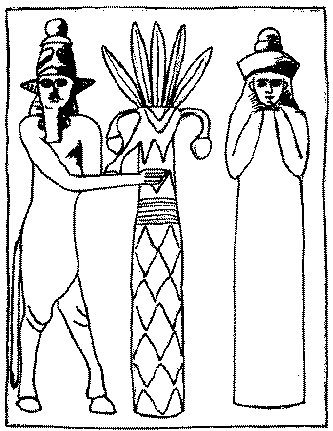
Enlil was the name of a chief deity in Babylonian religion, perhaps pronounced and sometimes rendered in translations as Ellil in later Akkadian. The name is Sumerian and has been believed to mean 'Lord Wind' though a more literal interpretation is 'Lord of the Command'.
Enlil was the god of wind, or the sky between earth and heaven. One story has him originate as the exhausted breath of An (God of the heavens) and Ki (goddess of the Earth) after sexual union. Another accounts is that he and his sister Ninhursag/Ninmah/Aruru were children of an obscure god Enki 'Lord Earth' (not the famous Enki) by Ninki 'Lady Earth'.
When Enlil was a young god, he was banished from Dilmun, home of the gods, to Kur, the underworld for raping a young girl named Ninlil. Ninlil followed him to the underworld where she bore his first child, the moon god Sin. After fathering three more underworld deities, Enlil was allowed to return to Dilmun.
Enlil was also known as the inventor of the pickaxe/hoe (favorite tool of the Sumerians) and the cause of plants growing. He was in possession of the holy Me, until he gave them to Enki for safe keeping, who summarily lost them to Inanna in a drunken stupor.
Enlil's relation to An 'Sky', in theory the supreme god of the Sumerian pantheon, was somewhat like that of a Frankish mayor of the palace compared to the king, or that of a Japanese shogun compared to the emperor, or to a prime minister in a modern constitutional monarchy compared to the supposed monarch. While An was in name ruler in the highest heavens, it was Enlil who mostly did the actual ruling over the world.
By his wife Ninlil or Sud, Enlil was father of the moon god Nanna (in Akkadian Sin) and of Ninurta (also called Ningirsu). Enlil is sometimes father of Nergal, of Nisaba the goddess of grain, of Pabilsag who is sometimes equated with Ninurta, and sometimes of Enbilulu. By Ereshkigal Enlil was father of Namtar.
Enlil is associated with the ancient city of Nippur, and since Enlu with the determinative for "land" or "district" is a common method of writing the name of the city, it follows, apart from other evidence, that Enlil was originally the patron deity of Nippur.
At a very early period - prior to 3000 BC - Nippur had become the centre of a political district of considerable extent. Inscriptions found at Nippur, where extensive excavations were carried on during 1888-1900 by Messrs Peters and Haynes, under the auspices of the University of Pennsylvania, show that Enlil was the head of an extensive pantheon. Among the titles accorded to him are "king of lands," "king of heaven and earth" and "father of the gods".
His chief temple at Nippur was known as Ekur, signifying 'House of the mountain', and such was the sanctity acquired by this edifice that Babylonian and Assyrian rulers, down to the latest days, vied with one another in embellishing and restoring Enlil's seat of worship, and the name Ekur became the designation of a temple in general.
Grouped around the main sanctuary, there arose temples and chapels to the gods and goddesses who formed his court, so that Ekur became the name for an entire sacred precinct in the city of Nippur.
The name "mountain house" suggests a lofty structure and was perhaps the designation originally of the staged tower at Nippur, built in imitation of a mountain, with the sacred shrine of the god on the top.
When, with the political rise of Babylon as the centre of a great empire, Nippur yielded its prerogatives to the city over which Marduk presided, the attributes and the titles of Enlil were largely transferred to Marduk.
But Enlil did not, however, entirely lose his right to have any considerable political importance, while in addition the doctrine of a triad of gods symbolizing the three divisions - heavens, earth and water - assured to Enlil, to whom the earth was assigned as his province, his place in the religious system.
It was no doubt in part Enlil's position as the second figure of the triad that enabled him to survive the political eclipse of Nippur and made his sanctuary a place of pilgrimage to which Assyrian kings down to the days of Assur-bani-pal paid their homage equally with Babylonian rulers.
The Sumerian ideogram for Enlil or Ellil was formerly incorrectly read as Bel by scholars, but in fact Enlil was not especially given the title Bel 'Lord' more than many other gods.
The Babylonian god Marduk is mostly the god persistently called Bel in late Assyrian and Babylonian inscriptions and it is Marduk that mostly appears in Greek and Latin texts as Belos or Belus. References in older literature to Enlil as the old Bel and Marduk as the young Bel derive from this error in reading.
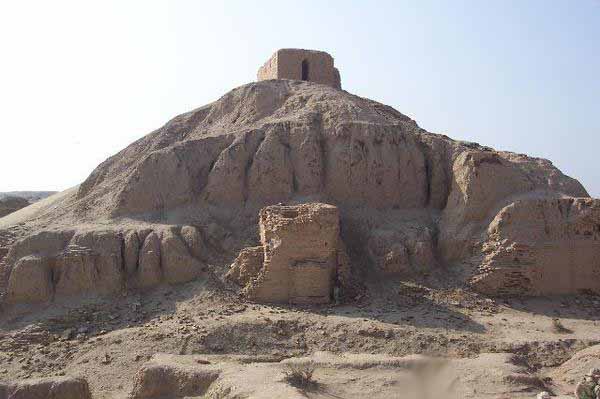

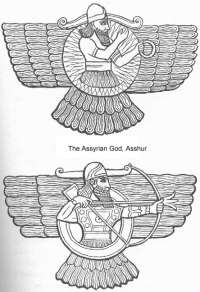
Winged Ashur is portrayed looking like the Faravahar or Zoroaster (Z).

Ashur was the national god of the Assyrians in ancient times until their gradual conversion to Christianity between the 1st and 5th centuries AD.
In Akkadian mythology and Sumerian mythology, Ashur is a sky god - husband of his sister Kishar; their children Lahmu and Lahamu, and the parents of Anu and Ea (and, in some traditions, Enlil). He is sometimes depicted as having Ninlil as a consort. As Anshar, he is progenitor of the Akkadian pantheon; as Ashur, he is the head of the Assyrian pantheon. He led the gods in the war against Tiamat.
Tiamat - According to Zecharia Sitchin's interpretation of Mesopotamian iconography and symbology, outlined in his 1976 book The 12th Planet and its sequels, there is an undiscovered planet beyond Neptune that follows a long, elliptical orbit, reaching the inner solar system roughly every 3,600 years. This planet is called Nibiru although Jupiter was the planet associated with the god Marduk in Babylonian cosmology.
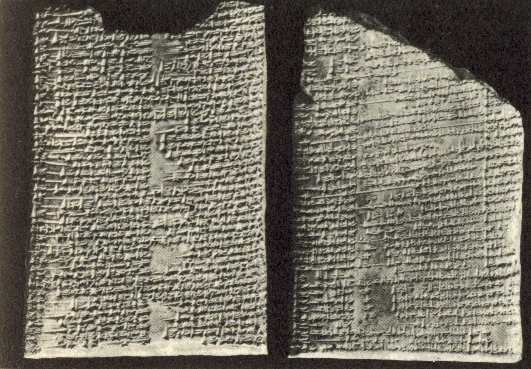
According to Sitchin, Nibiru - whose name was replaced with Marduk in original legends by the Babylonian ruler of the same name in an attempt to co-opt the creation for himself, leading to some confusion among readers - collided catastrophically with Tiamat a goddess in the Babylonian creation myth the Enuma Elish which he considers to be another planet once located between Mars and Jupiter.
This collision supposedly formed the planet Earth, the asteroid belt, and the comets. Sitchin states that when struck by one of planet Nibiru's moons, Tiamat split in two, and then on a second pass Nibiru itself struck the broken fragments and one half of Tiamat became the asteroid belt. The second half, struck again by one of Nibiru's moons, was pushed into a new orbit and became today's planet Earth.
According to Sitchin, Nibiru - called "the twelfth planet" because, Sitchin claimed, the Sumerians' gods-given conception of the Solar System counted all eight planets, plus Pluto, the Sun and the Moon - was the home of a technologically advanced human-like extraterrestrial race called the Anunnaki in Sumerian myth and the Nephilim in Genesis. He wrote that they evolved after Nibiru entered the solar system and first arrived on Earth probably 450,000 years ago, looking for minerals, especially gold, which they found and mined in Africa. Sitchin states that these "gods" were the rank-and-file workers of the colonial expedition to Earth from planet Nibiru.
Sitchin wrote that Enki suggested that to relieve the Anunnaki, who had mutinied over their dissatisfaction with their working conditions, that primitive workers (Homo sapiens) be created by genetic engineering as slaves to replace them in the gold mines by crossing extraterrestrial genes with those of Homo erectus.
According to Sitchin, ancient inscriptions report that the human civilization in Sumer, Mesopotamia, was set up under the guidance of these "gods", and human kingship was inaugurated to provide intermediaries between mankind and the Anunnaki (creating the "divine right of kings" doctrine). Sitchin believed that fallout from nuclear weapons, used during a war between factions of the extraterrestrials, is the "evil wind" described in the Lament for Ur that destroyed Ur around 2000 BC. Sitchin states the exact year is 2024 BC. Sitchin says that his research coincides with many biblical texts, and that biblical texts come originally from Sumerian writings. Read more ...

Milking scenes from the Temple of Ninhursag - Tell al Ubaid, c. 2400 B.C.

Ninhursag, the revered 'Mother of the Gods', embodied the power of compassion and nurturing qualities that played a pivotal role in maintaining divine harmony. As a mediator and healer among the gods, empathy and wisdom were key in resolving conflicts and fostering peace. Her presence offers a timeless reminder of the power of compassion and understanding in transforming even the most challenging situations. Just as comfort and tranquility were brought to the divine realm, Ninhursag's legacy encourages us to embrace these virtues in our own lives to navigate complexities and foster harmony.
In union with Enki she also bore Ninsar, goddess of the pasture. She was the chief nurse, the one in charge of medical facilities. In that role that the Goddess was called NINTI (lady-life). She was nicknamed 'Mammu' - now called 'mother' 'mom'.
Ninhursag bore a male child to Enlil. His name was NIN.UR.TA (lord who completes the fountain). He was the son who to do battle for his father using bolts of lightening.
In Egypt she played the roles of several creational goddesses - Isis, Maat and Hathor.

In Sumerian and Akkadian (Babylonian and Assyrian) mythology, Ereshkigal, wife of Nergal, was the goddess of Irkalla, the land of the dead. She managed the destiny of those who were beyond the grave, in the Underworld, where she was queen.
It was said that she had been stolen away by Kur and taken to the Underworld, where she was made queen unwillingly. She is actually the twin sister of Enki. Ereshkigal was the only one who could pass judgement and give laws in her kingdom, and her name means "Lady of the Great Place", "Lady of the Great Earth", or "Lady of the Great Below". Her main temples were at Kutha and Sippar. Read more ...
Ereshkigal was also Inanna and Ishtar (see below).

Inanna is the ancient Mesopotamian goddess of war, love, and fertility. She is also associated with political power, divine law, sensuality, and procreation. Originally worshipped in Sumer, she was known by the Akkadians, Babylonians, and Assyrians as Ishtar. Her primary title is "the Queen of Heaven".
She was the patron goddess of the Eanna temple at the city of Uruk, her early main religious center. In archaic Uruk, she was worshipped in three forms: morning Inanna (Inana-UD/hud), evening Inanna (Inanna sig), and princely Inanna (Inanna NUN), the former two reflecting the phases of her associated planet Venus.
Her most prominent symbols include the lion and the eight-pointed star. Her husband is the god Dumuzid (later known as Tammuz), and her sukkal (attendant) is the goddess Ninshubur, later conflated with the male deities Ilabrat and Papsukkal.
Inanna was worshipped in Sumer as early as the Uruk period (c. 4000 - 3100 BCE), and her worship was relatively localized before the conquest of Sargon of Akkad. During the post-Sargonic era, she became one of the most widely venerated deities in the Sumerian pantheon, with temples across Mesopotamia. Adoration of Inanna/Ishtar was continued by the East Semitic-speaking peoples (Akkadians, Assyrians and Babylonians) who succeeded and absorbed the Sumerians in the region.
She was especially beloved by the Assyrians, who elevated her to become the highest deity in their pantheon, ranking above their own national god Ashur. Inanna/Ishtar is alluded to in the Hebrew Bible[citation needed], and she greatly influenced the Ugaritic goddess Ashtart and later the Phoenician goddess Astarte, who in turn possibly influenced the development of the Greek goddess Aphrodite. Her worship continued to flourish until its gradual decline between the first and sixth centuries CE in the wake of Christianity.
Inanna appears in more myths than any other Sumerian deity. She also has a uniquely high number of epithets and alternate names, comparable only to Nergal.
Many of her myths involve her taking over the domains of other deities. She is believed to have been given the mes, which represent all positive and negative aspects of civilization, by Enki, the god of wisdom. She is also believed to have taken over the Eanna temple from An, the god of the sky.
Alongside her twin brother Utu (later known as Shamash), Inanna is the enforcer of divine justice; she destroyed Mount Ebih for having challenged her authority, unleashed her fury upon the gardener Shukaletuda after he raped her in her sleep, and tracked down the bandit woman Bilulu and killed her in divine retribution for having murdered Dumuzid. In the standard Akkadian version of the Epic of Gilgamesh, Ishtar asks Gilgamesh to become her consort. When he disdainfully refuses, she unleashes the Bull of Heaven, resulting in the death of Enkidu and Gilgamesh's subsequent grapple with his own mortality.
Inanna's most famous myth is the story of her descent into and return from the ancient Mesopotamian underworld, ruled by her older sister Ereshkigal. After she reaches Ereshkigal's throne room, the seven judges of the underworld deem her guilty and strike her dead. Three days later, Ninshubur pleads with all the gods to bring Inanna back. All of them refuse her, except Enki, who sends two sexless beings to rescue Inanna.
They escort Inanna out of the underworld but the galla, the guardians of the underworld, drag her husband Dumuzid down to the underworld as her replacement. Dumuzid is eventually permitted to return to heaven for half the year, while his sister Geshtinanna remains in the underworld for the other half, resulting in the cycle of the seasons. Read more ...
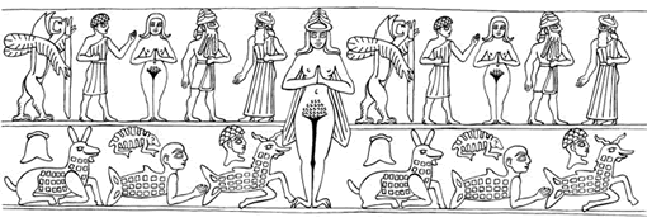
Mesopotamian cylinder seal. Hematite. 2000-1600 BCE.
Inanna was said to descend from the ancient family of the creator goddess Nammu, who was her grandmother. Inanna held "full power of judgment and decision and the control of the law of heaven and earth." Her sacred planet was Venus, the evening star. She was often symbolized as a lioness in battle. Along the Tigris and Euphrates rivers were many shrines and temples dedicated to her.
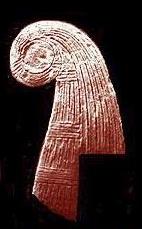 -
- 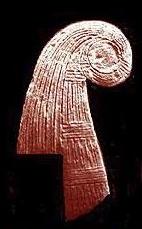
On either side of her cult statue shown above is the ring-post, also known as Inanna's knot- in Egypt the Atef Crown. This was a sacred symbol of Inanna, associated with her. It represents a door-post made from a bundle of reeds, the upper ends, bent into a loop to hold a cross-pole. The ring-post is shown on many depictions of Inanna, including those of the famed Warka Vase.
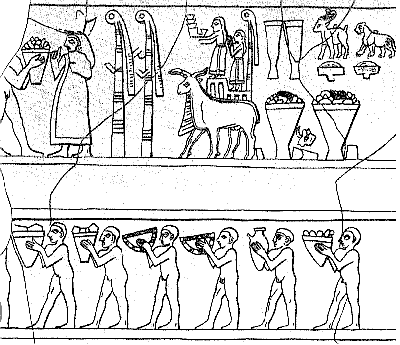
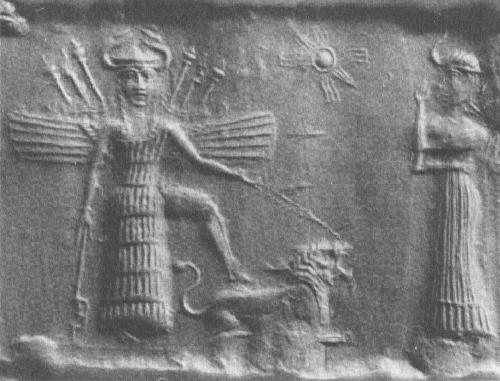
Inanna could be wily and cunning. She was a powerful warrior, who drove a war chariot, drawn by lions. In the duality of our reality she is portrayed as gentle and loving, a source of beauty and grace, a source of inspiration. She endowed the people of Sumer with gifts that inspired and insured their growth as a people and a culture. She is also depicted as a passionate, sensuous lover in The Courtship of Inanna and Dumuzi (see below), which established the principle of Sacred Marriage. Indeed, one aspect of Inanna is as the Goddess of Love, and it is in this aspect that she embodies creativity, procreativity, passion, raw sexual energy and power.
During the time the Goddess Inanna ruled the people of Sumer, they and their communities prospered. The urban culture, though agriculturally dependent, centered upon the reverence of the Goddess - a cella, or shrine, in her honor was the centerpiece of the cities. Inanna was the queen of seven temples throughout Sumer.
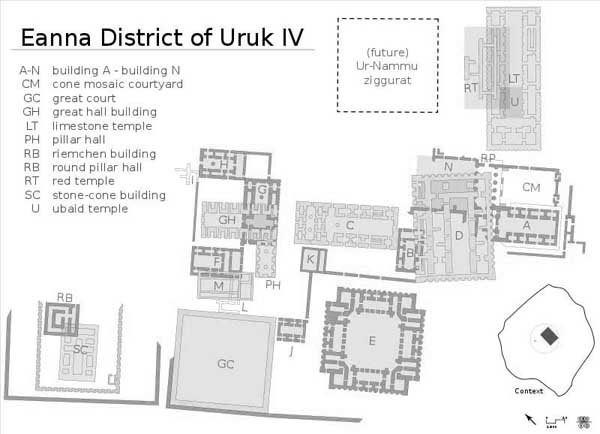
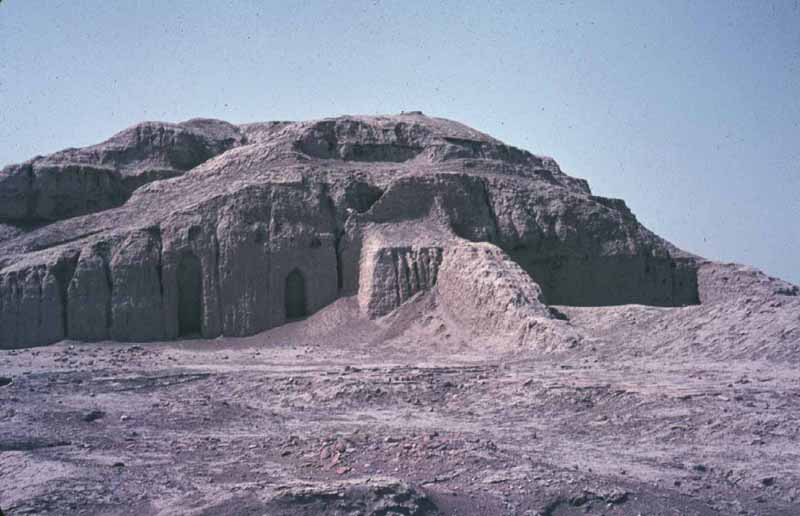
The temple of EAnna, Inanna's House of Heaven, in Uruk, was the greatest of these. This temple was 5000 years old and had been built and rebuilt many times to hold a community of sacred women who cared for the temple lands. The high priestess of Inanna would choose for her bed one she would appoint as shepherd. He would represent Dumuzi, her sacred lover.
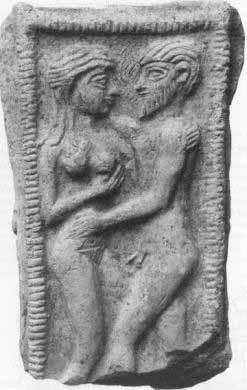
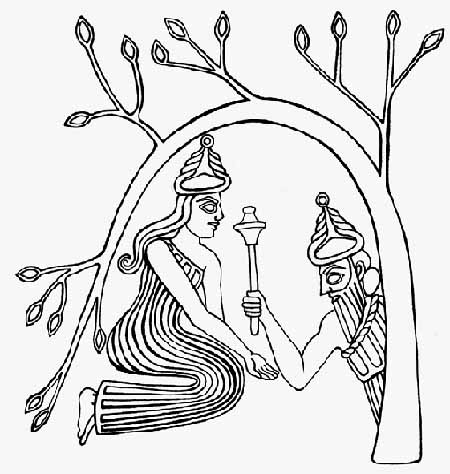
Eanna and Dumuzi create the Tree of Life
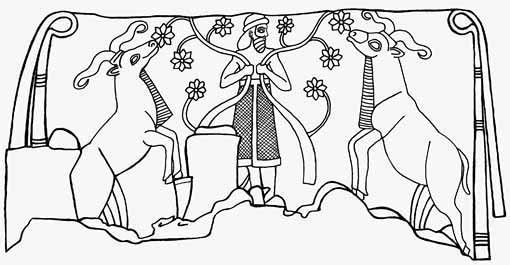
Mesopotamian cylinder seal - 3200-3000 BCE.
is an ancient Mesopotamian and Levantine deity associated with agriculture and shepherds, who was also the first and primary consort of the goddess Inanna (later known as Ishtar). In Sumerian mythology, Dumuzid's sister was Geshtinanna, the goddess of agriculture, fertility, and dream interpretation. In the Sumerian King List, Dumuzid is listed as an antediluvian king of the city of Bad-tibira and also an early king of the city of Uruk.
"Dumuzid the Shepherd" is also the subject of a series of epic poems in Sumerian literature. However, he is described in these tablets as king of Uruk, the title given by the King List to Dumuzid the Fisherman - a distinct figure said to have ruled sometime after the Flood, in between Lugalbanda "the Shepherd" and Gilgamesh.
Among the mythical compositions involving Dumuzid the Shepherd are:
Inanna's descent to the netherworld: Inanna, after descending to the underworld, is allowed to return, but only with an unwanted entourage of demons, who insist on taking away a notable person in her place. She dissuades the demons from taking the rulers of Umma and Bad-tibira, who are sitting in dirt and rags. However, when they come to Uruk, they find Dumuzid the Shepherd sitting in palatial opulence, and seize him immediately, taking him into the underworld as Inanna's substitute.
Dumuzid and Ngeshtin-ana: Inanna gives Dumuzid over to the demons as her substitute; they proceed to violate him, but he escapes to the home of his sister, Ngeshtin-ana (Geshtinanna). The demons pursue Dumuzid there, and eventually find him hiding in the pasture.
Dumuzid and his sister: Fragmentary. Dumuzid's sister seems to be mourning his death in this tablet.
Dumuzid's dream: In this account, Dumuzid dreams of his own death and tells Ngeshtin-ana, who tells him it is a sign that he is about to be toppled in an uprising by evil and hungry men (also described as galla, 'demons') who are coming to Uruk for the king. No sooner does she speak this, than men of Adab, Akshak, Uruk, Ur, and Nibru are indeed sighted coming for him with clubs. Dumuzid resolves to hide in the district of Alali, but they finally catch him. He escapes from them and reaches to the district of Kubiresh, but they catch him again. Escaping again to the house of Old Woman Belili, he is again caught, but then escapes once more to his sister's home. There he is caught a last time, hiding in the pasture, and killed.
Inanna and Bilulu: This describes how Inanna avenges her lover Dumuzid's death, by killing Old Woman Bilulu (or Belili). Read more ...
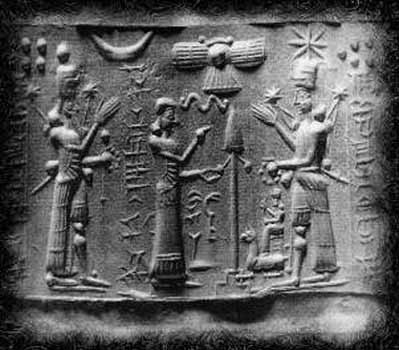
Inanna would play Isis and Ishtar, among others.
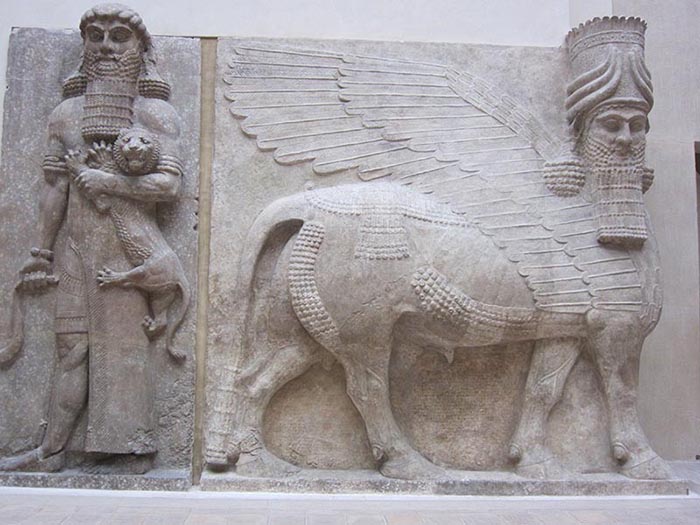
Gilgamesh
The goddess Inanna was the patron and special god/goddess of the ancient Sumerian city of Erech (Uruk), the City of Gilgamesh. As Queen of heaven, she was associated with the Evening Star (the planet Venus), and sometimes with the Moon. She may also have been associated the brightest stars in the heavens, as she is sometimes symbolized by an eight-pointed star, a seven-pointed star, or a four pointed star. In the earliest traditions, Inanna was the daughter of An, the Sky, Ki, the Earth (both of Uruk and Warka). In later Sumerian traditions, she is the daughter of Nanna (Narrar), the Moon God and Ningal, the Moon Goddess (both of Ur).
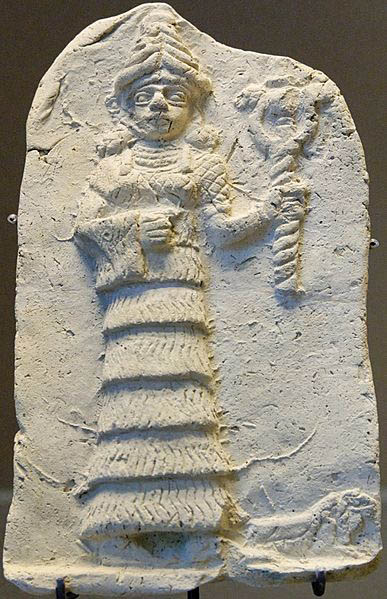
Ishtar - Louvre Museum
Ishtar is a prominent goddess in Mesopotamian mythology, known by various names like Inanna in Sumerian. She is primarily associated with love, war, and fertility, and is considered a powerful figure in the Mesopotamian pantheon.
Ishtar is the Akkadian counterpart to the Sumerian Inanna and to the cognate northwest Semitic goddess Astarte. Anunit, Astarte and Atarsamain are alternative names for Ishtar. Inanna, twin of Utu/Shamash, children of Nannar/Sin, first born on Earth of Enlil. The first names given are Sumerian, the second names derive from the Akkadians, who are a Semitic people who immigrated into Sumeria. Adding an [sh] to a name is typical Akkadian, as Anu to Anush.
The goddess represents the planet Venus. (A continent on Venus is named Ishtar Terra by astronomers today.) The double aspect of the goddess may correspond to the difference between Venus as a morning star and as an evening star. In Sumerian the planet is called "MUL.DILI.PAT" meaning "unique star".
The name Inanna (sometimes spelled Inana) means "Great Lady of An", where An is the god of heaven. The meaning of Ishtar is not known, though it is possible that the underlying stem is the same as that of Assur, which would thus make her the "leading one" or "chief". In any event, it is now generally recognized that the name is Semitic in origin.
The Sumerian Inanna was first worshiped at Uruk (Erech in the Bible, Unug in Sumerian) in the earliest period of Mesopotamian history. In incantations, hymns, myths, epics, votive inscriptions, and historical annals, Inanna/Ishtar was celebrated and invoked as the force of life. But there were two aspects to this goddess of life. She was the goddess of fertility and sexuality, and could also destroy the fields and make the earth's creatures infertile. She was invoked as a goddess of war, battles, and the chase, particularly among the warlike Assyrians. Before the battle Ishtar would appear to the Assyrian army, clad in battle array and armed with bow and arrow. (compare Greek Athena.)
One of the most striking Sumerian myths describes Inanna passing through seven gates of hell into the underworld. At each gate some of her clothing and her ornaments are removed until at the last gate she is entirely naked. Ereshkigal, the queen of the underworld kills her and hangs her corpse on a hook on the wall.
When Inanna returns from the underworld by intercession of the clever god, her uncle, Enki, according to the rules she must find someone to take her place. On her way home she encounters her friends prostrated with grief at her loss, but in Kulaba, her cult city, she finds her lover Dumuzi, a son of Enki, Tammuz seated in splendour on a throne, so she has him seized and dragged below. Later, missing him, she arranges for his sister to substitute for him during six months of the year.
In all the great centres Inanna and then Ishtar had her temples: E-anna, "house of An", in Uruk; E-makh, "great house", in Babylon; E-mash-mash, "house of offerings", in Nineveh. Inanna was the guardian of prostitutes, and probably had priestess-prostitutes to serve her. She was served by priests as well as by priestesses. The (later) votaries of Ishtar were virgins who, as long as they remained in her service, were not permitted to marry.
Inanna was also associated with beer, and was the patroness of tavern keepers, who were usually female in early Mesopotamia.
Ishtar is also an omnipresent figure in the epic of Gilgamesh. She appears also on the Uruk vase, one of the most famous ancient Mesopotamian artifacts. The relief on this vase seems to show Inanna conferring kingship on a supplicant. Various inscriptions and artifacts indicate that kingship was one of the gifts bestowed by Inanna on the ruler of Uruk.
On monuments and seal-cylinders Inanna/Ishtar appears frequently with bow and arrow, though also simply clad in long robes with a crown on her head and an eight-rayed star as her symbol. Statuettes have been found in large numbers representing her as naked with her arms folded across her breast or holding a child.
Together with the moon god Nanna or Suen (Sin in Akkadian), and the sun god Utu (Shamash in Akkadian), Inanna/Ishtar is the third figure in a triad deifying and personalizing the moon, the sun, and the earth: Moon (wisdom), Sun (justice) and Earth (life force). This triad overlies another: An, heaven; Enlil, earth; and Enki (Ea in Akkadian), the watery deep.
Ishtar's Symbol: an eight or sixteen-pointed star Sacred number: 15 Astrological region: Dibalt(Venus) and the Bowstar (Sirius) Sacred animal: lion, (dragon)
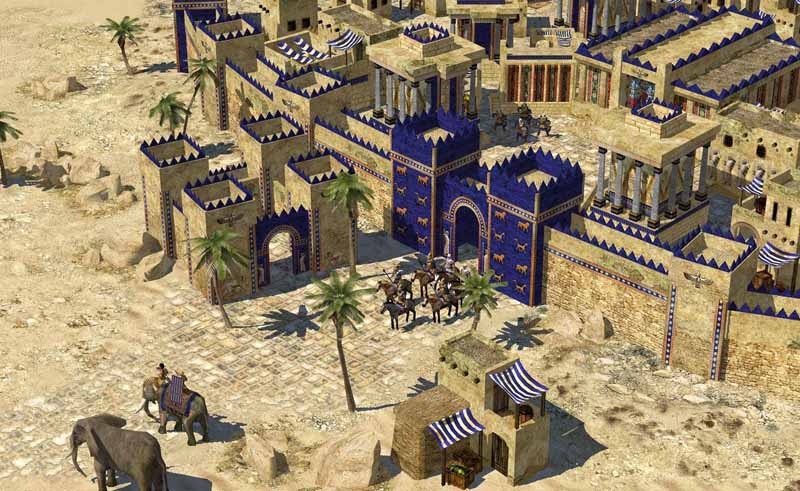
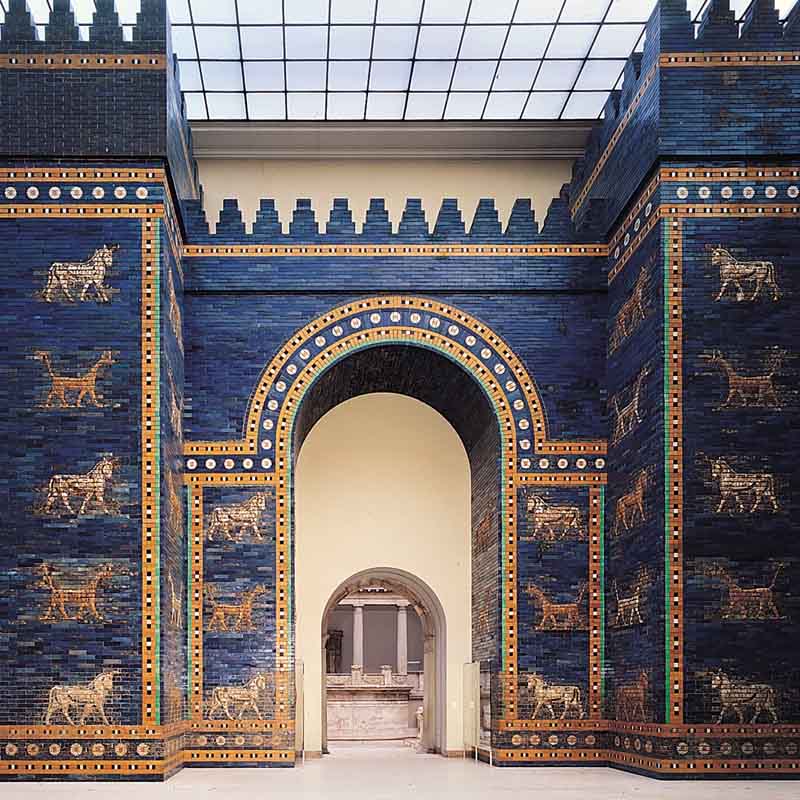
The Ishtar Gate survives today in the Pergamon Museum in Berlin.
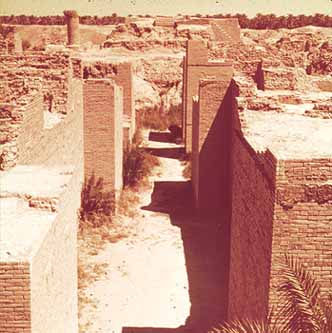
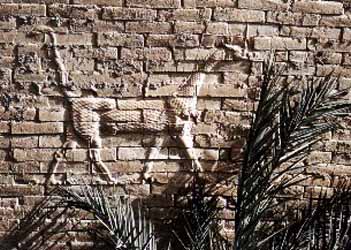
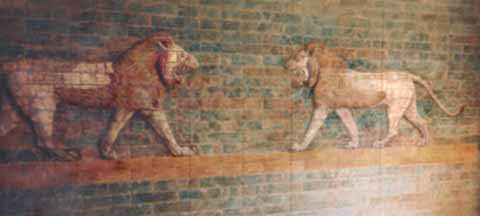
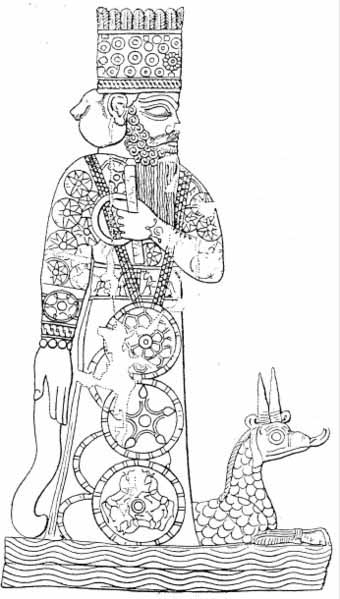
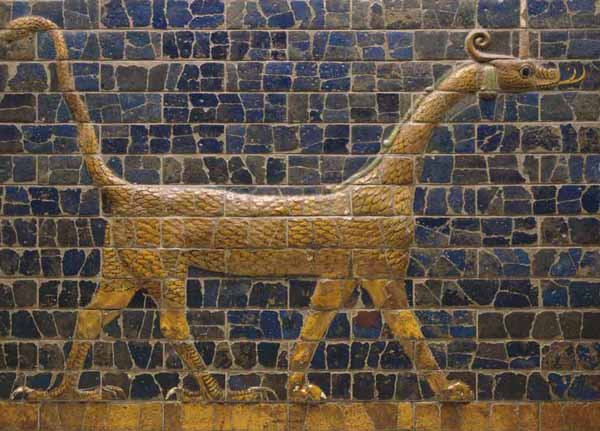
Snake-Dragon, Symbol of Marduk, the Patron God of Babylon.
Panel from the Ishtar Gate, 604-562 BCE, glazed earthenware bricks.
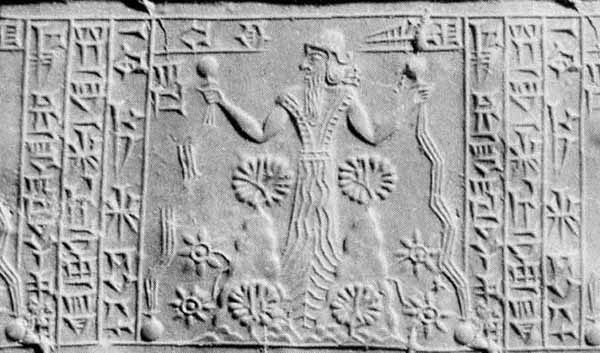
Marduk (Sumerian spelling in Akkadian AMAR.UTU "solar calf"; Biblical Merodach) was the name of a late generation god from ancient Mesopotamia and patron deity of the city of Babylon, who, when Babylon permanently became the political center of the Euphrates valley in the time of Hammurabi (18th century BC), started to slowly rise to the position of the head of the Babylonian pantheon, position he fully acquired by the second half of the second millennium BCE.
Marduk's original character is obscure, but whatever special traits Marduk may have had were overshadowed by the reflex of the political development through which the Euphrates valley passed and which led to imbuing him with traits belonging to gods who at an earlier period were recognized as the heads of the pantheon.
There are more particularly two gods - Ea and Enlil - whose powers and attributes pass over to Marduk. In the case of Ea the transfer proceeds pacifically and without involving the effacement of the older god. Marduk is viewed as the son of Ea. The father voluntarily recognizes the superiority of the son and hands over to him the control of humanity. This association of Marduk and Ea, while indicating primarily the passing of the supremacy once enjoyed by Eridu to Babylon as a religious and political centre, may also reflect an early dependence of Babylon upon Eridu, not necessarily of a political character but, in view of the spread of culture in the Euphrates valley from the south to the north, the recognition of Eridu as the older centre on the part of the younger one.
While the relationship between Ea and Marduk is thus marked by harmony and an amicable abdication on the part of the father in favor of his son, Marduk's absorption of the power and prerogatives of Enlil of Nippur was at the expense of the latter's prestige. After the days of Hammurabi, the cult of Marduk eclipses that of Enlil, and although during the four centuries of Kassite control in Babylonia (c. 1570 BC-1157 BC), Nippur and the cult of Enlil enjoyed a period of renaissance, when the reaction ensued it marked the definite and permanent triumph of Marduk over Enlil until the end of the Babylonian empire. The only serious rival to Marduk after ca. 1000 BC is Anshar in Assyria. In the south Marduk reigns supreme. He is normally referred to as Bel "Lord".

Enuma Elish
When Babylon became the capital of Mesopotamia, the patron deity of Babylon was elevated to the level of supreme god. In order to explain how Marduk seized power, Enuma Elish, was written, which tells the story of Marduk's birth, heroic deeds, and becoming the ruler of the gods. This can be viewed as a form of Mesopotamian apologetics.
In Enuma Elish a civil war between the gods was growing to a climatic battle. The Anunnaki gods gathered together to find one god who could defeat the gods rising against them. Marduk, a very young god, answered the call, and was promised the position of head god.When he killed his enemy he "wrested from him the Tablets of Destiny, wrongfully his" and assumed his new position. Under his reign humans were created to bear the burdens of life so the gods could be at leisure.
People were named after Marduk. For example, the Biblical personality Mordechai (Book of Esther) used this Gentile name in replacement of his Hebrew name Bilshan.Ba bylonian texts talk of the creation of Eridu by the god Marduk as the first city, 'the holy city, the dwelling of their the other gods delight'.
Nabu, god of wisdom, is a son of Marduk.
Etemenanki, "The temple of the creation of heaven and earth", was the name of a ziggurat to Marduk in the city of Babylon of the 6th century BC Chaldean (Neo-Babylonian) dynasty. Originally seven stories in height, little remains of it now save ruins. Etemenanki was later popularly identified with the Tower of Babel.

In Sumerian mythology, Nammu (more properly Namma) was a primeval goddess, corresponding to Tiamat in Babylonian mythology. Taimat was a primordial goddess who rose from the void and created the world.
Nammu was the primeval sea (Engur) that gave birth to An - Anu (heaven) and Ki (earth) and the first gods, representing the Apsu, the fresh water ocean that the Sumerians believed lay beneath the earth, the source of life-giving water and fertility in a country with almost no rainfall.
Nammu is not well attested in Sumerian mythology. She may have been of greater importance prehistorically, before Enki took over most of her functions. An indication of her continued relevance may be found in the theophoric name of Ur-Nammu, the founder of the Third Dynasty of Ur.
According to the Neo-Sumerian mythological text Enki and Ninmah, Enki is the son of An and Nammu. Nammu is the goddess who "has given birth to the great gods". It is she who has the idea of creating mankind, and she goes to wake up Enki, who is asleep in the Apsu, so that he may set the process going. Read more ...
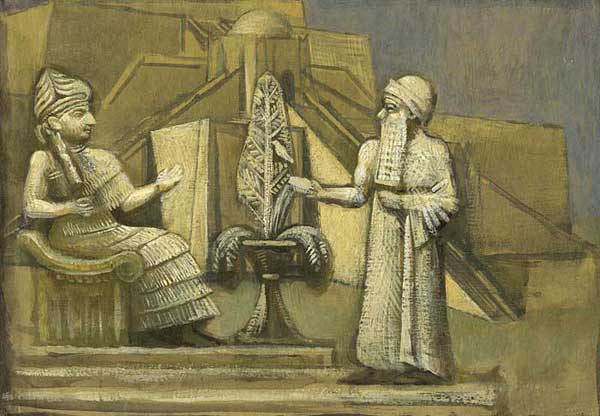
Nammu and the Tree of Life at Ur
Ur-Nammu founded the Sumerian Third Dynasty of Ur, in southern Mesopotamia, following several centuries of Akkadian and Gutian rule. Though he built many temples and canals his main achievement was building the core of the Ur III Empire via military conquest, and Ur-Nammu is chiefly remembered today for his legal code, the Code of Ur-Nammu, the oldest known surviving example in the world. He held the titles of "King of Ur, and King of Sumer and Akkad". His personal goddess was Ninsuna. Read more ...

Stelae of Ur-Nammu at Ur
Ur-Nammu founded the Sumerian 3rd dynasty of Ur, in southern Mesopotamia, following several centuries of Akkadian and Gutian rule. His main achievement was state-building, and Ur-Nammu is chiefly remembered today for his legal code, the Code of Ur-Nammu, the oldest known surviving example in the world.
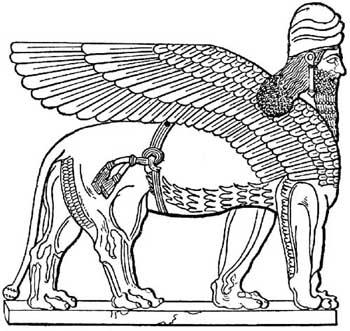
Nergal refers to a deity in Babylon with the main seat of his cult at Cuthah represented by the mound of Tell-Ibrahim. Nergal is mentioned in the Hebrew bible as the deity of the city of Cuth (Cuthah): "And the men of Babylon made Succoth-benoth, and the men of Cuth made Nergal" (2 Kings, 17:30). According to the rabbins, his emblem was a cock and Nergal means a "dunghill cock". He is the son of Enlil and Ninlil.
Nergal actually seems to be in part a solar deity, sometimes identified with Shamash, but a representative of a certain phase only of the sun. Portrayed in hymns and myths as a god of war and pestilence, Nergal seems to represent the sun of noontime and of the summer solstice which brings destruction to mankind, high summer being the dead season in the Mesopotamian annual cycle.
Nergal was also the deity who presides over the nether-world, and who stands at the head of the special pantheon assigned to the government of the dead (supposed to be gathered in a large subterranean cave known as Aralu or Irkalla). In this capacity he has associated with him a goddess Allatu or Ereshkigal, though at one time Allatu may have functioned as the sole mistress of Aralu, ruling in her own person. In some texts the god Ninazu is the son of Nergal by Allatu/Ereshkigal.
Ordinarily Nergal pairs with his consort Laz. Standard iconography pictured Nergal as a lion, and boundary-stone monuments symbolise him with a mace surmounted by the head of a lion.
Nergal's fiery aspect appears in names or epithets such as Lugalgira, Sharrapu ("the burner," perhaps a mere epithet), Erra, Gibil (though this name more properly belongs to Nusku), and Sibitti. A certain confusion exists in cuneiform literature between Ninurta and Nergal. Nergal has epithets such as the "raging king," the "furious one," and the like. A play upon his name separated into three elements as Ne-uru-gal (lord of the great dwelling) expresses his position at the head of the nether-world pantheon.
In the astral-theological system Nergal becomes the planet Mars, while in ecclesiastical art the great lion-headed colossi serving as guardians to the temples and palaces seem to symbolise Nergal, just as the bull-headed colossi probably typify Ninurta.
Nergal's chief temple at Cuthah bore the name Meslam, from which the god receives the designation of Meslamtaeda or Meslamtaea, "the one that rises up from Meslam". The name Meslamtaeda/Meslamtaea indeed is found as early as the list of gods from Fara while the name Nergal only begins to appear in the Akkadian period.
The cult of Nergal does not appear to have spread as widely as that of Ninurta. Hymns and votive and other inscriptions of Babylonian and Assyrian rulers frequently invoke him, but we do not learn of many temples to him outside of Cuthah. Sennacherib speaks of one at Tarbisu to the north of Nineveh, but significantly, although Nebuchadnezzar II (606 BC 586 BC), the great temple-builder of the neo-Babylonian monarchy, alludes to his operations at Meslam in Cuthah, he makes no mention of a sanctuary to Nergal in Babylon. Local associations with his original seat Kutha and the conception formed of him as a god of the dead acted in making him feared rather than actively worshipped.

Shamash or Sama, was the common Akkadian name of the sun-god in Babylonia and Assyria, corresponding to Sumerian Utu.
The name signifies perhaps "servitor," and would thus point to a secondary position occupied at one time by this deity. Both in early and in late inscriptions Sha-mash is designated as the "offspring of Nannar," i.e. of the moon-god, and since, in an enumeration of the pantheon, Sin generally takes precedence of Shamash, it is in relationship, presumably, to the moon-god that the sun-god appears as the dependent power.
Such a supposition would accord with the prominence acquired by the moon in the calendar and in astrological calculations, as well as with the fact that the moon-cult belongs to the nomadic and therefore earlier, stage of civilization, whereas the sun-god rises to full importance only after the agricultural stage has been reached.
The two chief centres of sun-worship in Babylonia were Sippar, represented by the mounds at Abu Habba, and Larsa, represented by the modern Senkerah. At both places the chief sanctuary bore the name E-barra (or E-babbara) "the shining house" a direct allusion to the brilliancy of the sun-god. Of the two temples, that at Sippara was the more famous, but temples to Shamash were erected in all large centres such as Babylon, Ur, Mari, Nippur and Nineveh.
The attribute most commonly associated with Shamash is justice. Just as the sun disperses darkness, so Shamash brings wrong and injustice to light. Hammurabi attributes to Shamash the inspiration that led him to gather the existing laws and legal procedures into a code, and in the design accompanying the code the king represents himself in an attitude of adoration before Shamash as the embodiment of the idea of justice.
Several centuries before Hammurabi, Ur-Engur of the Ur dynasty (c. 2600 BC) declared that he rendered decisions "according to the just laws of Shamash."
It was a logical consequence of this conception of the sun-god that he was regarded also as the one who released the sufferer from the grasp of the demons. The sick man, therefore, appeals to Shamash as the god who can be depended upon to help those who are suffering unjustly. This aspect of the sun-god is vividly brought out in the hymns addressed to him, which are, therefore, among the finest productions in the entire realm of Babylonian literature.
It is evident from the material at our disposal that the Shamash cults at Sippar and Larsa so overshadowed local sun-deities elsewhere as to lead to an absorption of the minor deities by the predominating one. In the systematized pantheon these minor sun-gods become attendants that do his service. Such are Bunene, spoken of as his chariot driver, whose consort is Atgi-makh, Kettu ("justice") and Mesharu ("right"), who are introduced as servitors of Shamash.
Other sun-deities, as Ninurta and Nergal, the patron deities of important centres, retained their independent existence as certain phases of the sun, Ninib becoming the sun-god of the morning and of the spring time, and Nergal the sun-god of the noon and of the summer solstice, while Shamash was viewed as the sun-god in general.
Together with Sin and Ishtar, Shamash forms a second triad by the side of Anu, Enlil and Ea. The three powers, Sin, Shamash and Ishtar, symbolized the three great forces of nature, the sun, the moon and the life-giving force of the earth.
At times, instead of Ishtar, we find Adad, the storm-god, associated with Sin and Shamash, and it may be that these two sets of triads represent the doctrines of two different schools of theological thought in Babylonia which were subsequently harmonized by the recognition of a group consisting of all four deities.
The consort of Shamash was known as A. She, however, is rarely mentioned in the inscriptions except in combination with Shamash.
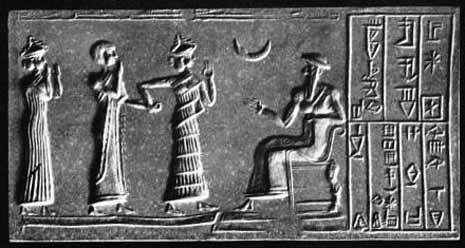
Impression of the cylinder seal of Hashamer - High Priest of Sin at Iskun Sin ca. 2100 BC. The seated figure is probably king Ur-Nammu, bestowing the governorship on Hashamer, who is led before him by a lamma (protective goddess). Sin/Nanna himself is present in the form of a crescent.

Sin was the god of the moon in Mesopotamian mythology. Nanna is a Sumerian deity, the son of Enlil and Ninlil, and became identified with Semitic Sin. The two chief seats of Nanna's/Sin's worship were Ur in the south of Mesopotamia and Harran in the north.
He is commonly designated as En-zu, which means "lord of wisdom". During the period (c.2600-2400 BCE) that Ur exercised a large measure of supremacy over the Euphrates valley, Sin was naturally regarded as the head of the pantheon. It is to this period that we must trace such designations of Sin as "father of the gods", "chief of the gods", "creator of all things", and the like. The "wisdom" personified by the moon-god is likewise an expression of the science of astronomy or the practice of astrology, in which the observation of the moon's phases is an important factor.
His wife was Ningal ("Great Lady"), who bore him Utu/Shamash ("Sun") and Inanna/Ishtar (the goddess of the planet Venus). The tendency to centralize the powers of the universe leads to the establishment of the doctrine of a triad consisting of Sin/Nanna and his children.
Sin had a beard made of lapis lazuli and rode on a winged bull. The bull was one of his symbols, through his father, Enlil, "Bull of Heaven", along with the crescent and the tripod (which may be a lamp-stand). On cylinder seals, he is represented as an old man with a flowing beard and the crescent symbol. In the astral-theological system he is represented by the number 30 and the moon. This number probably refers to the average number of days (correctly around 29.53) in a lunar month, as measured between successive new moons.
An important Sumerian text ("Enlil and Ninlil") tells of the descent of Enlil and Ninlil, pregnant with Nanna/Suen, into the underworld. There, three "substitutions" are given to allow the ascent of Nanna/Suen. The story shows some similarities to the text known as "The Descent of Inanna".
Nanna's chief sanctuary at Ur was named E-gish-shir-gal ("house of the great light"). It was at Ur that the role of the En Priestess developed. This was an extremely powerful role held by a princess, most notably Enheduanna, daughter of King Sargon of Akkad, and was the primary cult role associated with the cult of Nanna/Sin. Sin also had a sanctuary at Harran, named E-khul-khul ("house of joys"). The cult of the moon-god spread to other centers, so that temples to him are found in all the large cities of Babylonia and Assyria. A sanctuary for Sin with Syriac inscriptions invoking his name dating to the 2nd and 3rd centuries CE was found at Sumatar Harabesi in the Tektek mountains, not far from Harran and Edessa.
Enkidu is a central figure in the Ancient Mesopotamian Epic of Gilgamesh. Enkidu was first created by Anu, the sky god, to rid Gilgamesh of his arrogance. In the story he is a wild man, a Tarzan figure, raised by animals and ignorant of human society until he is bedded by Shamhat.
Thereafter a series of interactions with humans and human ways bring him closer to civilization, culminating in a wrestling match with Gilgamesh, king of Uruk. Enkidu embodies the wild or natural world, and though equal to Gilgamesh in strength and bearing, acts in some ways as an antithesis to the cultured, urban-bred warrior-king. Enkidu then becomes the king's constant companion and deeply beloved friend, accompanying him on adventures until he is stricken ill.
The deep, tragic loss of Enkidu profoundly inspires in Gilgamesh a quest to escape death by obtaining godly immortality. Older sources sometimes transliterate his name as Enkimdu, Eabani, or Enkita. Enkidu is a modern variant.
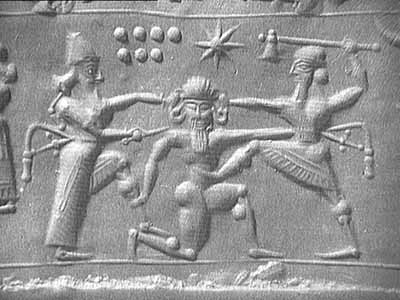
Enkidu assists Gilgamesh in defeating and killing Humbaba, the guardian monster of the Cedar Forest. Afterwards, he again assists Gilgamesh in slaying Gugalanna the Bull of Heaven, which the gods have sent to kill Gilgamesh as a reprisal for spurning the goddess Ishtar's affections while enumerating the misfortunes that befell her former lovers.
Ishtar demands that the pair pay for the bull's destruction. Shamash argues to the other gods to spare both of them, but could only save Gilgamesh. The gods pass judgment that Enkidu had no justification for fighting the Bull of Heaven and was interfering with their will. Enkidu then is overcome by a severe illness. Near death, he has visions of a gloomy afterlife, and curses the trapper and Shamhat for civilizing him. He retracts his curse on Shamhat, however, after Shamash scolds him, reminding him that it was Shamhat who taught him the pleasures of civilization, and ultimately, brought him to Gilgamesh - a Sumerian Demi-God.
Gilgamesh mourns over the body of Enkidu for several desperate days. In a vivid line repeated in the epic, Gilgamesh only allows his friend to be buried after a maggot falls out of the corpse's nose. Gilgamesh's close observation of rigor mortis and the slow decomposition of Enkidu's body provides the hero with the impetus for his quest for eternal life, and his visit to Utnapishtim.
There is another non-canonical tablet in which Enkidu journeys into the underworld, but many scholars consider the tablet to be a sequel or add-on to the original epic. Read more ...

Ngeshtin-ana is a minor goddess in Sumerian mythology, the so-called "heavenly grape-vine". The sister of Dumuzi and consort of Ningisida, she is involved in the account of Dumuzi trying to escape his fate at the hands of Inana and Ereshkigal. In her house he is changed into a gazelle before being caught and transported to the underworld.
Alsoknow as Geshtinanna - she was a Mesopotamian goddess best known due to her role in myths about the death of Dumuzi, her brother. It is not certain what functions she fulfilled in the Mesopotamian pantheon, though her association with the scribal arts and dream interpretation is well attested. She could serve as a scribe in the underworld, where according to the myth Inanna's Descent she had to reside for a half of each year in place of her brother.
In Sumerian mythology:
When Dumuzi died, Geshtinanna lamentated days and nights.
After her death, she became the goddess of wine and cold seasons. She is a divine poet and interpreter of dreams.
Gugalanna is the first husband of Ereshkigal, the queen of the underworld. His name probably originally meant "canal inspector of An" and he may be merely an alternative name for Ennugi.
The son of Ereshkigal and Gugalanna is Ninazu.
In Inanna's Descent into the Underworld, Inanna, the goddess of love, beauty, sex, and war, tells the gatekeeper Neti that she is descending to the Underworld to attend the funeral of "Gugalanna, the husband of my elder sister Ereshkigal".
Some scholars consider Gugalanna to be the same figure as the Bull of Heaven, slain by Gilgamesh and Enkidu in the Epic of Gilgamesh.
In Mesopotamian mythology, Gugalanna (lit. "The Great Bull of Heaven") was a Sumerian deity as well as a constellation known today as Taurus, one of the twelve signs of the Zodiac.
Gugalanna was the first husband of the Goddess Ereshkigal, the Goddess of the Realm of the Dead, a gloomy place devoid of light, who was dispatched by Inanna to punish Gilgamesh for his sins.
Gugalanna was sent by the gods to take retribution upon Gilgamesh for rejecting the sexual advances of the goddess Inanna.
Gugalanna, whose feet made the earth shake, was slain and dismembered by Gilgamesh and Enkidu.
Inanna, from the heights of the city walls looked down, and Enkidu took the haunches of the bull shaking them at the goddess, threatening he would do the same to her if he could catch her too. For this impiety, Enkidu later dies.
It was to share the sorrow with her sister that Inanna later descends to the Underworld.
Taurus was the constellation of the Northern Hemisphere Spring Equinox from about 3,200 BCE. It marked the start of the agricultural year with the New Year Akitu festival an important date in Mespotamian religion.
The "death" of Gugalanna, represents the obscuring disappearance of this constellation as a result of the light of the sun, with whom Gilgamesh was identified.
In the time in which this myth was composed, the New Year Festival, or Akitu, at the Spring Equinox, due to the Precession of the Equinoxes did not occur in Aries, but in Taurus. At this time of the year, Taurus would have disappeared as it was obscured by the sun.
In Akkadian mythology Humbaba (Assyrian spelling) or Huwawa (Sumerian spelling), also 'Humbaba the Terrible' was a monstrous giant of immemorial age raised by Utu, the Sun. Humbaba was the guardian of the Cedar Forest, where the gods lived, by the will of the god Enlil, who assigned Humbaba as a terror to human beings. He is the brother of Pazuzu and Enki and son of Hanbi.
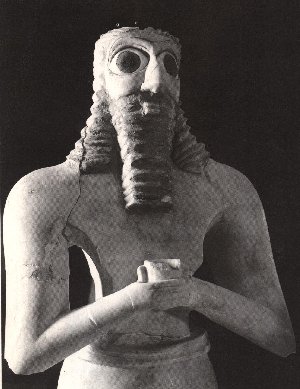
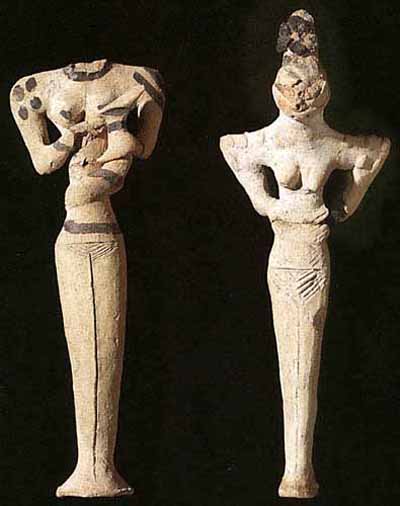
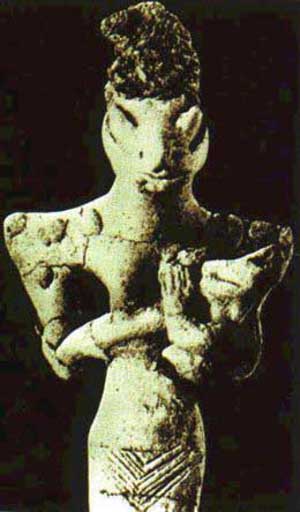
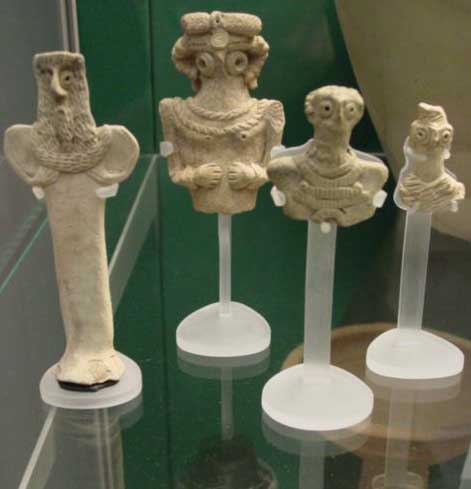

The Garden of Eden